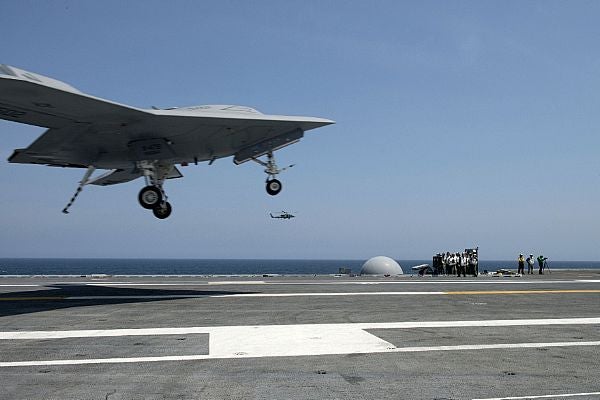
The US Navy’s Northrop Grumman-built X-47B unmanned combat air system demonstrator (UCAS-D) carrier demonstration aircraft has successfully completed its first arrested landing on Nimitz-class super carrier, USS George H W Bush (CVN 77), off the coast of Virginia, US.
Marking a step ahead in integrating the unmanned aircraft systems seamlessly into navy carrier operations, the landing trial has been conduct as final part of three at-sea test periods for X-47B programme.
During testing, the X-47B aircraft caught the three-wire with the aircraft’s tailhook following its 35-minute travel from the Naval Air Station (NAS) Patuxent River, Maryland, US, to the aircraft carrier.
The unmanned system performed the arrested landing effectively by stopping from a speed of 145k in less than 350ft, while a mission operator aboard the carrier took control of the aircraft and monitored the flight operations.
US Navy UCAS programme manager captain Jaime Engdahl said the recent trials confirmed the unmanned systems can be seamlessly integrated into the carrier environment.
Further arrested landing trial has been conducted by the UCAS-D using the ship’s catapult shortly after completing initial landing off the carrier.
Northrop Grumman Aerospace Systems vice-president and Navy UCAS programme manager Carl Johnson said: "Although it looks like it could be an easy maneouvre, today’s successful arrested landings points back to a rigorous test plan focused on software development and system maturity to prove today that an autonomous unmanned system such as the X-47B can safely, seamlessly and predictably integrate into navy carrier operations."
Northrop Grumman-led team for the UCAS-D programme includes Pratt & Whitney, GKN Aerospace, Eaton, General Electric, UTC Aerospace Systems, Dell, Honeywell, Moog, Wind River, Parker Aerospace, Rockwell Collins and Lockheed Martin.
The 38.2ft-long tailless autonomous aircraft will be fitted with both probe-and-drogue for the US Navy as well as boom-receptacle mechanisms for the USAF for autonomous air refuelling.
Image: The X-47B lands aboard USS George H W Bush. Photo: courtesy of US Navy, by mass communication specialist 1st class Arif Patani/Released.





